[English] 日本語
 Yorodumi
Yorodumi- PDB-3mrr: Crystal Structure of MHC class I HLA-A2 molecule complexed with H... -
+ Open data
Open data
- Basic information
Basic information
| Entry | Database: PDB / ID: 3mrr | ||||||
|---|---|---|---|---|---|---|---|
| Title | Crystal Structure of MHC class I HLA-A2 molecule complexed with Human Prostaglandin Transporter decapeptide | ||||||
 Components Components |
| ||||||
 Keywords Keywords | IMMUNE SYSTEM / MHC class I / HLA / IMMUNE RESPONSE / DECAPEPTIDE / PROSTAGLANDIN TRANSPORTER / TUMORAL PEPTIDE / MELAN-A ANALOGUE / MART1 ANALOGUE / SELF PEPTIDE | ||||||
| Function / homology |  Function and homology information Function and homology informationDefective SLCO2A1 causes primary, autosomal recessive hypertrophic osteoarthropathy 2 (PHOAR2) / Organic anion transport by SLCO transporters / sodium-independent organic anion transport / : / prostaglandin transport / prostaglandin transmembrane transporter activity / lipid transporter activity / positive regulation of memory T cell activation / T cell mediated cytotoxicity directed against tumor cell target / TAP complex binding ...Defective SLCO2A1 causes primary, autosomal recessive hypertrophic osteoarthropathy 2 (PHOAR2) / Organic anion transport by SLCO transporters / sodium-independent organic anion transport / : / prostaglandin transport / prostaglandin transmembrane transporter activity / lipid transporter activity / positive regulation of memory T cell activation / T cell mediated cytotoxicity directed against tumor cell target / TAP complex binding / Golgi medial cisterna / positive regulation of CD8-positive, alpha-beta T cell activation / CD8-positive, alpha-beta T cell activation / positive regulation of CD8-positive, alpha-beta T cell proliferation / lipid transport / CD8 receptor binding / antigen processing and presentation of exogenous peptide antigen via MHC class I / beta-2-microglobulin binding / endoplasmic reticulum exit site / TAP binding / antigen processing and presentation of endogenous peptide antigen via MHC class I via ER pathway, TAP-dependent / protection from natural killer cell mediated cytotoxicity / antigen processing and presentation of endogenous peptide antigen via MHC class Ib / antigen processing and presentation of endogenous peptide antigen via MHC class I via ER pathway, TAP-independent / detection of bacterium / T cell receptor binding / basal plasma membrane / negative regulation of receptor binding / early endosome lumen / Nef mediated downregulation of MHC class I complex cell surface expression / DAP12 interactions / transferrin transport / cellular response to iron ion / Endosomal/Vacuolar pathway / Antigen Presentation: Folding, assembly and peptide loading of class I MHC / peptide antigen assembly with MHC class II protein complex / lumenal side of endoplasmic reticulum membrane / cellular response to iron(III) ion / negative regulation of forebrain neuron differentiation / MHC class II protein complex / antigen processing and presentation of exogenous protein antigen via MHC class Ib, TAP-dependent / ER to Golgi transport vesicle membrane / peptide antigen assembly with MHC class I protein complex / regulation of iron ion transport / regulation of erythrocyte differentiation / HFE-transferrin receptor complex / response to molecule of bacterial origin / MHC class I peptide loading complex / T cell mediated cytotoxicity / positive regulation of T cell cytokine production / antigen processing and presentation of endogenous peptide antigen via MHC class I / antigen processing and presentation of exogenous peptide antigen via MHC class II / positive regulation of immune response / MHC class I protein complex / peptide antigen binding / positive regulation of T cell activation / positive regulation of receptor-mediated endocytosis / negative regulation of neurogenesis / cellular response to nicotine / positive regulation of T cell mediated cytotoxicity / multicellular organismal-level iron ion homeostasis / specific granule lumen / positive regulation of type II interferon production / phagocytic vesicle membrane / recycling endosome membrane / Interferon gamma signaling / Immunoregulatory interactions between a Lymphoid and a non-Lymphoid cell / negative regulation of epithelial cell proliferation / MHC class II protein complex binding / Interferon alpha/beta signaling / Modulation by Mtb of host immune system / late endosome membrane / sensory perception of smell / positive regulation of cellular senescence / tertiary granule lumen / antibacterial humoral response / DAP12 signaling / T cell differentiation in thymus / T cell receptor signaling pathway / E3 ubiquitin ligases ubiquitinate target proteins / negative regulation of neuron projection development / ER-Phagosome pathway / protein refolding / early endosome membrane / protein homotetramerization / basolateral plasma membrane / amyloid fibril formation / intracellular iron ion homeostasis / learning or memory / lysosome / defense response to Gram-positive bacterium / immune response / endoplasmic reticulum lumen / Amyloid fiber formation / signaling receptor binding / Golgi membrane / innate immune response / lysosomal membrane / external side of plasma membrane / focal adhesion Similarity search - Function | ||||||
| Biological species |  Homo sapiens (human) Homo sapiens (human) | ||||||
| Method |  X-RAY DIFFRACTION / X-RAY DIFFRACTION /  SYNCHROTRON / SYNCHROTRON /  MOLECULAR REPLACEMENT / Resolution: 1.6 Å MOLECULAR REPLACEMENT / Resolution: 1.6 Å | ||||||
 Authors Authors | Reiser, J.-B. / Machillot, P. / Chouquet, A. / Debeaupuis, E. / Echasserieau, K. / Legoux, F. / Saulquin, X. / Bonneville, M. / Housset, D. | ||||||
 Citation Citation |  Journal: J.Immunol. / Year: 2014 Journal: J.Immunol. / Year: 2014Title: Analysis of Relationships between Peptide/MHC Structural Features and Naive T Cell Frequency in Humans. Authors: Reiser, J.B. / Legoux, F. / Gras, S. / Trudel, E. / Chouquet, A. / Leger, A. / Le Gorrec, M. / Machillot, P. / Bonneville, M. / Saulquin, X. / Housset, D. | ||||||
| History |
|
- Structure visualization
Structure visualization
| Structure viewer | Molecule:  Molmil Molmil Jmol/JSmol Jmol/JSmol |
|---|
- Downloads & links
Downloads & links
- Download
Download
| PDBx/mmCIF format |  3mrr.cif.gz 3mrr.cif.gz | 100.1 KB | Display |  PDBx/mmCIF format PDBx/mmCIF format |
|---|---|---|---|---|
| PDB format |  pdb3mrr.ent.gz pdb3mrr.ent.gz | 75 KB | Display |  PDB format PDB format |
| PDBx/mmJSON format |  3mrr.json.gz 3mrr.json.gz | Tree view |  PDBx/mmJSON format PDBx/mmJSON format | |
| Others |  Other downloads Other downloads |
-Validation report
| Summary document |  3mrr_validation.pdf.gz 3mrr_validation.pdf.gz | 438.1 KB | Display |  wwPDB validaton report wwPDB validaton report |
|---|---|---|---|---|
| Full document |  3mrr_full_validation.pdf.gz 3mrr_full_validation.pdf.gz | 439.6 KB | Display | |
| Data in XML |  3mrr_validation.xml.gz 3mrr_validation.xml.gz | 18.3 KB | Display | |
| Data in CIF |  3mrr_validation.cif.gz 3mrr_validation.cif.gz | 26.5 KB | Display | |
| Arichive directory |  https://data.pdbj.org/pub/pdb/validation_reports/mr/3mrr https://data.pdbj.org/pub/pdb/validation_reports/mr/3mrr ftp://data.pdbj.org/pub/pdb/validation_reports/mr/3mrr ftp://data.pdbj.org/pub/pdb/validation_reports/mr/3mrr | HTTPS FTP |
-Related structure data
| Related structure data |  3mrcC 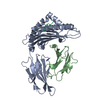 3mrdC 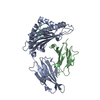 3mreC  3mrgC  3mrhC  3mrlC  3mroC  3mrpS C: citing same article ( S: Starting model for refinement |
|---|---|
| Similar structure data |
- Links
Links
- Assembly
Assembly
| Deposited unit | 
| ||||||||
|---|---|---|---|---|---|---|---|---|---|
| 1 |
| ||||||||
| Unit cell |
|
- Components
Components
| #1: Protein | Mass: 34008.711 Da / Num. of mol.: 1 / Fragment: HLA-A*0201 alpha chain, UNP resiude 25-300 / Mutation: A245V Source method: isolated from a genetically manipulated source Details: C-terminal biotin acceptor peptide sequence tag (GSLHHILDAQKMVWNHR) Source: (gene. exp.)  Homo sapiens (human) / Gene: HLA, HLA-A, HLAA / Plasmid: pHN1 / Production host: Homo sapiens (human) / Gene: HLA, HLA-A, HLAA / Plasmid: pHN1 / Production host:  |
|---|---|
| #2: Protein | Mass: 11879.356 Da / Num. of mol.: 1 Source method: isolated from a genetically manipulated source Source: (gene. exp.)  Homo sapiens (human) / Gene: B2M, BETA-2 MICROGLUBULIN, CDABP0092, HDCMA22P / Plasmid: pHN1 / Production host: Homo sapiens (human) / Gene: B2M, BETA-2 MICROGLUBULIN, CDABP0092, HDCMA22P / Plasmid: pHN1 / Production host:  |
| #3: Protein/peptide | Mass: 953.177 Da / Num. of mol.: 1 Fragment: Transproter protein fragment, UNP residues 178-187 Source method: obtained synthetically / Details: chemical synthesis / Source: (synth.)  Homo sapiens (human) / References: UniProt: Q92959 Homo sapiens (human) / References: UniProt: Q92959 |
| #4: Water | ChemComp-HOH / |
| Has protein modification | Y |
-Experimental details
-Experiment
| Experiment | Method:  X-RAY DIFFRACTION / Number of used crystals: 1 X-RAY DIFFRACTION / Number of used crystals: 1 |
|---|
- Sample preparation
Sample preparation
| Crystal | Density Matthews: 2.44 Å3/Da / Density % sol: 49.51 % |
|---|---|
| Crystal grow | Temperature: 293 K / Method: vapor diffusion, hanging drop / pH: 6.5 Details: 15% PEG 6000, 0.1M NaCitrate, 0.1M NaCl, 3mg/ml protein conc., pH 6.5, VAPOR DIFFUSION, HANGING DROP, temperature 293K |
-Data collection
| Diffraction | Mean temperature: 100 K | ||||||||||||||||||||||||||||||||||||||||||||||||||||||||||||||||||||||||||||||||||||||||||||||||||
|---|---|---|---|---|---|---|---|---|---|---|---|---|---|---|---|---|---|---|---|---|---|---|---|---|---|---|---|---|---|---|---|---|---|---|---|---|---|---|---|---|---|---|---|---|---|---|---|---|---|---|---|---|---|---|---|---|---|---|---|---|---|---|---|---|---|---|---|---|---|---|---|---|---|---|---|---|---|---|---|---|---|---|---|---|---|---|---|---|---|---|---|---|---|---|---|---|---|---|---|
| Diffraction source | Source:  SYNCHROTRON / Site: SYNCHROTRON / Site:  ESRF ESRF  / Beamline: ID23-2 / Wavelength: 0.9834 Å / Beamline: ID23-2 / Wavelength: 0.9834 Å | ||||||||||||||||||||||||||||||||||||||||||||||||||||||||||||||||||||||||||||||||||||||||||||||||||
| Detector | Type: ADSC QUANTUM 315r / Detector: CCD / Date: Jun 22, 2009 | ||||||||||||||||||||||||||||||||||||||||||||||||||||||||||||||||||||||||||||||||||||||||||||||||||
| Radiation | Protocol: SINGLE WAVELENGTH / Monochromatic (M) / Laue (L): M / Scattering type: x-ray | ||||||||||||||||||||||||||||||||||||||||||||||||||||||||||||||||||||||||||||||||||||||||||||||||||
| Radiation wavelength | Wavelength: 0.9834 Å / Relative weight: 1 | ||||||||||||||||||||||||||||||||||||||||||||||||||||||||||||||||||||||||||||||||||||||||||||||||||
| Reflection | Resolution: 1.6→50 Å / Num. obs: 55551 / % possible obs: 93.7 % / Observed criterion σ(I): -3 / Redundancy: 3.43 % / Biso Wilson estimate: 31.354 Å2 / Rmerge(I) obs: 0.032 / Net I/σ(I): 21.82 | ||||||||||||||||||||||||||||||||||||||||||||||||||||||||||||||||||||||||||||||||||||||||||||||||||
| Reflection shell | Diffraction-ID: 1
|
- Processing
Processing
| Software |
| |||||||||||||||||||||||||||||||||||||||||||||||||||||||||||||||||
|---|---|---|---|---|---|---|---|---|---|---|---|---|---|---|---|---|---|---|---|---|---|---|---|---|---|---|---|---|---|---|---|---|---|---|---|---|---|---|---|---|---|---|---|---|---|---|---|---|---|---|---|---|---|---|---|---|---|---|---|---|---|---|---|---|---|---|
| Refinement | Method to determine structure:  MOLECULAR REPLACEMENT MOLECULAR REPLACEMENTStarting model: PDB ENTRY 3MRP Resolution: 1.6→14.89 Å / Cor.coef. Fo:Fc: 0.96 / Cor.coef. Fo:Fc free: 0.947 / Occupancy max: 1 / Occupancy min: 0.5 / SU B: 1.527 / SU ML: 0.053 / Cross valid method: THROUGHOUT / σ(F): 0 / ESU R Free: 0.1 / Stereochemistry target values: MAXIMUM LIKELIHOOD Details: U VALUES: REFINED INDIVIDUALLY; 10 to 20 refinement cycles with all observed reflections were performed at the end of the refinement procedure, in order to obtain the most accurate model. ...Details: U VALUES: REFINED INDIVIDUALLY; 10 to 20 refinement cycles with all observed reflections were performed at the end of the refinement procedure, in order to obtain the most accurate model. Rwork and Rfree values corresponds to the coordinates just before these very last cycles.
| |||||||||||||||||||||||||||||||||||||||||||||||||||||||||||||||||
| Solvent computation | Ion probe radii: 0.8 Å / Shrinkage radii: 0.8 Å / VDW probe radii: 1.4 Å / Solvent model: BABINET MODEL WITH MASK | |||||||||||||||||||||||||||||||||||||||||||||||||||||||||||||||||
| Displacement parameters | Biso max: 76.76 Å2 / Biso mean: 33.406 Å2 / Biso min: 15.42 Å2
| |||||||||||||||||||||||||||||||||||||||||||||||||||||||||||||||||
| Refinement step | Cycle: LAST / Resolution: 1.6→14.89 Å
| |||||||||||||||||||||||||||||||||||||||||||||||||||||||||||||||||
| Refine LS restraints |
| |||||||||||||||||||||||||||||||||||||||||||||||||||||||||||||||||
| LS refinement shell | Resolution: 1.6→1.641 Å / Total num. of bins used: 20
|
 Movie
Movie Controller
Controller


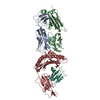

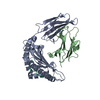
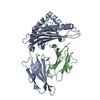
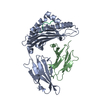
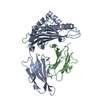
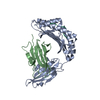
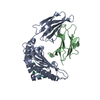

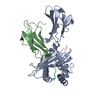



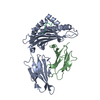



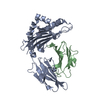
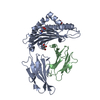
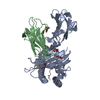

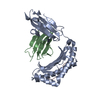
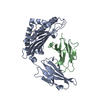
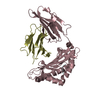
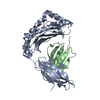
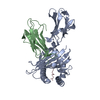

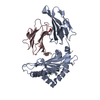
 PDBj
PDBj








